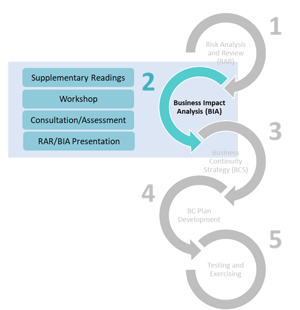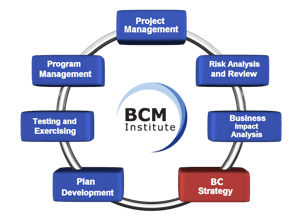Overview
![]() At this stage, you are about to attend the half day BCM workshop organised in-house. This "Risk Analysis and Review phase" session was conducted already and this is followed by the Business Impact Analysis phase, which usually may not be on the same day.
At this stage, you are about to attend the half day BCM workshop organised in-house. This "Risk Analysis and Review phase" session was conducted already and this is followed by the Business Impact Analysis phase, which usually may not be on the same day.
Again, it may be useful if you have not read the first two articles regarding how this project started, you may want to read "[1] Starting the Project" and "[2] Developing BCM Structure and Framework."
This article is the fourth part of the "Funded BCM Project" series. This is the reading for participants embarking on a BCM implementation using a combination of training with SSG funding from the Singapore government and consulting to develop, implement and finalize its BCM program for an organisation.
Business impact analysis or BIA is the process of analysing the effects of interruptions on business functions, and the organisation as a whole. And based on the severity of these effects, the participant or BCM Planner would be able to infer the relative recovery priorities of these business functions.

The process of conducting the "Business Impact Analysis" or "BIA" in the funded BCM Project is as follows:
 1. Supplementary Readings
1. Supplementary Readings
- Participants will receive emails containing bite-size information on business impact analysis.
- The purpose of doing so is to introduce them to the key concepts ahead of the coming workshop.
- This helps participants optimize their time at the workshop.
What participants should do:
Participants are encouraged to read through the supplementary material and jot down any questions they may have.
2. Workshop
 A workshop is conducted to guide business unit BCM coordinators to collect data on:
A workshop is conducted to guide business unit BCM coordinators to collect data on:
- Critical business functions (CBFs),
- Potential impacts of a prolonged disruption of CBFs
- Time periods within which the CBFs must be recovered, in order to minimize losses
- Key dependencies to perform CBFs
- Resources necessary to perform CBFs
Templates are used to facilitate the BIA data collection process.
What participants should do (before coming to the workshop):
As the BIA is an important cornerstone of the business continuity planning process, participants are encouraged to read the email supplementary materials before the workshop.
Participants should load the templates into their laptops and bring them along to the workshop.
It is important to note that because the workshop is a 1-time group event, it is important that participants lock this event in their calendars. No repeat workshop will be conducted for absent participants.
3. Consultation
After the workshop, participants will have one week to complete and submit the templates to their Organisation BCM Coordinator, who will consolidate the templates and send the batch to the consultant. The duration of one week may be shorter depending on the project schedule provide to you by your Organisation BCM Coordinator.
Post workshop, you will be submitting the template to the consultant for review. A teleconversation or video conferencing consultation session (approx. 30 mins) has been arranged for individual departments to go through the templates with the consultants.
What participants should do (before coming to the workshop):
- Submit the BIA templates to your BCM Coordinator on time
- Before the consultation/assessment session, review your templates, and quickly read through the course materials
- Attend the consultation/assessment session at the appointed time
- If there are any changes required, submit a revised completed template to your BCM Coordinator.
The consultant will process the templates from all departments and write a report for submission to the organisation's management.
4. RAR & BIA Presentation
.jpeg?width=300&name=Senior%20Management%20Briefing%20(2).jpeg) At this juncture, it is appropriate to update senior management on the progress of the project, as well as to present to them the interim findings of the RAR and BIA. Once the findings are endorsed, the reports are finalized and submitted.
At this juncture, it is appropriate to update senior management on the progress of the project, as well as to present to them the interim findings of the RAR and BIA. Once the findings are endorsed, the reports are finalized and submitted.
What senior management should do:
- Review the key risks for the organization (RAR)
- Review the list of critical business functions and their recovery time objectives (BIA)
- Endorse the findings.
Henceforth, during the next two phases, the business continuity strategy (BCS) and plan development (PD) phases, that are developed will be based on these endorsed findings.
4. Next Session: Business Continuity Strategy
 Once this session is completed, you are now ready to attend the half-day of the BCM-5000 course . Read more for what is the expectation for the the next 1/2-day workshop, which "Evaluating the Business Continuity Strategy".
Once this session is completed, you are now ready to attend the half-day of the BCM-5000 course . Read more for what is the expectation for the the next 1/2-day workshop, which "Evaluating the Business Continuity Strategy".
Sometime, this session can be held separately due to time constraint from the participants. Check your schedule as provided by your Organisational BCM Coordinator.
We will enter into the Business Continuity Strategy phase of the project only after management endorsement of the RAR and BIA findings.
Should there be any turnover of your business unit BCM Coordinator after the completion of the project, you can send the incoming designated staff member to the next BCM course which is funded by Skillsfuture Singapore (SSG). Click on the link below to read on the courses suitable for them:
Competency Based Training to Update Current BCM Plans



